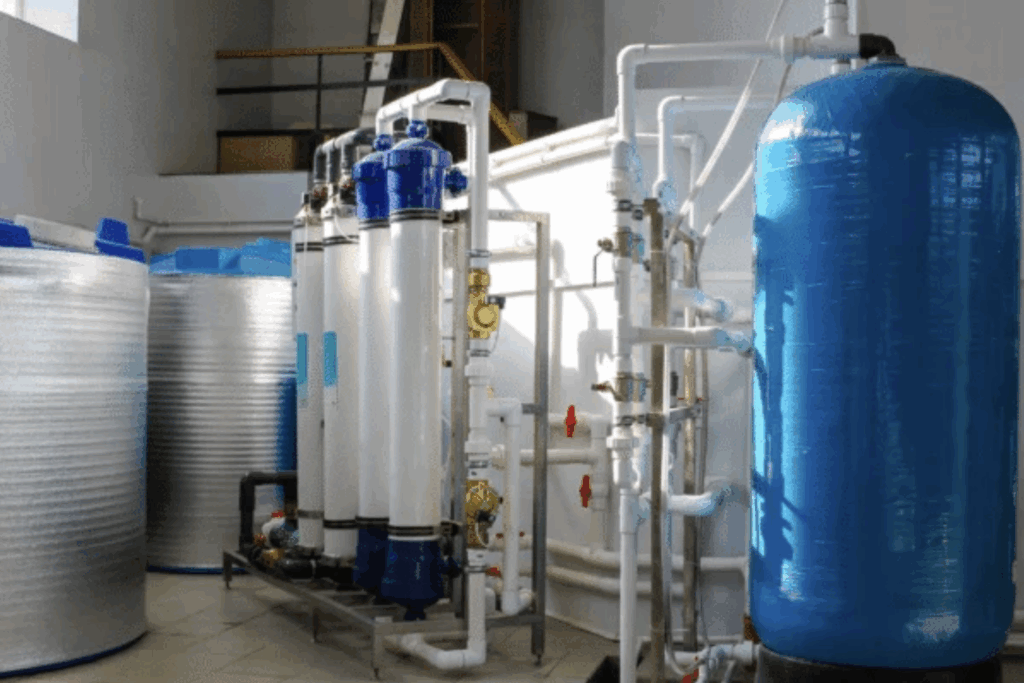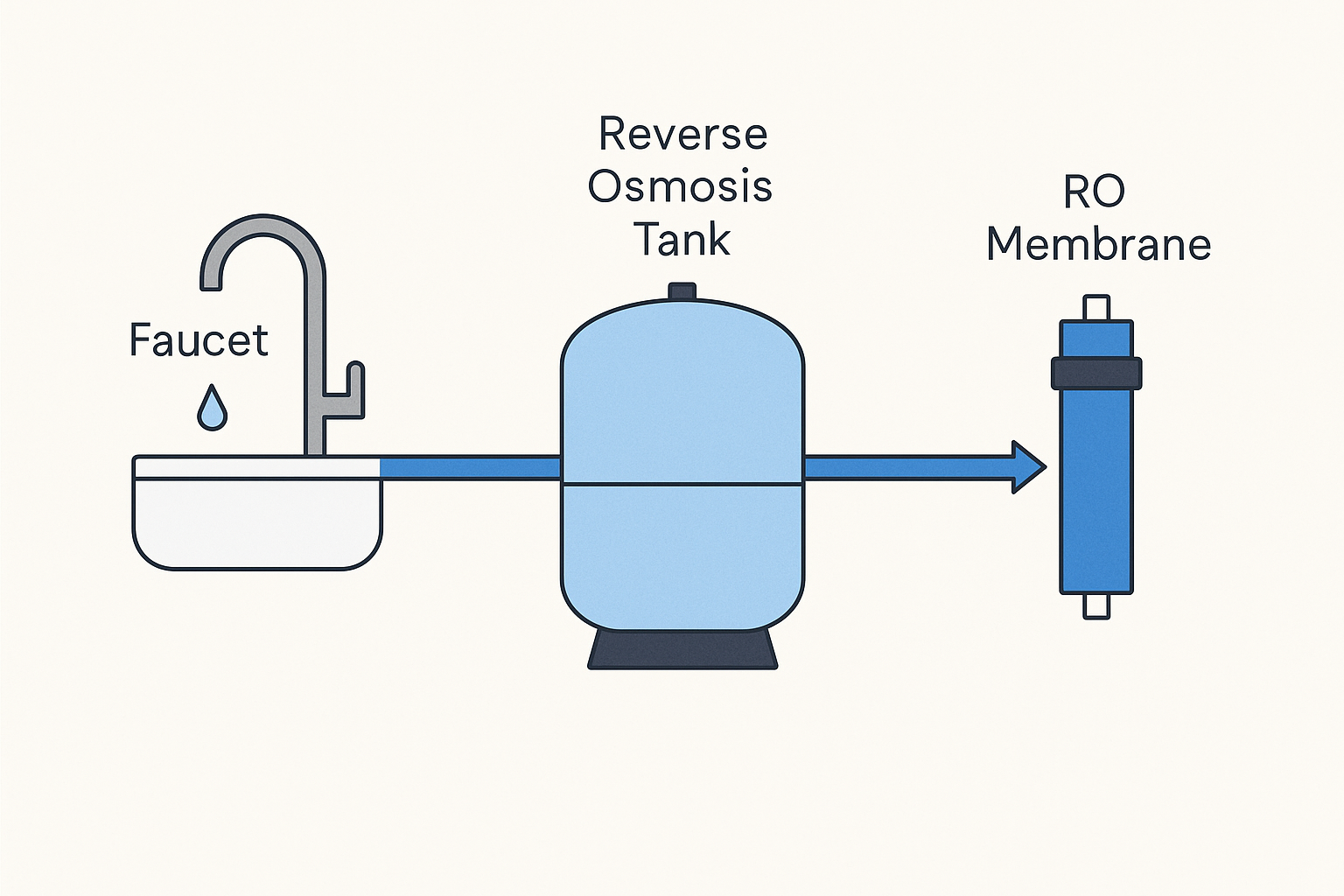The Role of the Reverse Osmosis Tank in Water Purification Systems
A reverse osmosis tank, often called a reverse osmosis storage tank, is a sealed water storage container that holds purified water produced by an RO system. Its design combines an air chamber and a water chamber separated by a flexible diaphragm. The tank stores purified water under controlled tank pressure, which allows water to flow easily to the faucet or sink when needed.
Most tanks are factory tested, built with durable materials, and designed to withstand the maximum working pressure specified for residential or light industrial use. These tanks are an integral part of ensuring the water remains water safe, readily available, and at the proper flow rate.

How the Reverse Osmosis Tank Supports the RO System
The osmosis tank plays a vital role in supporting the RO system by providing consistent pressure and flow of purified water. Without a storage tank, an RO membrane alone could not produce water fast enough to meet household or light industrial demand. The tank acts as a buffer, ensuring water is available on demand without overloading the system.

When you turn on the faucet, water from the tank flows to the sink at the right tank pressure, rather than forcing the system to work harder each time. This improves the longevity of the RO membrane and ensures customer satisfaction by providing reliable water when it is needed most.
Learn more on our blog: How to Perform a Reverse Osmosis Membrane Replacement
Features and Specifications of RO Tanks
Reverse osmosis tanks are available in a variety of capacities and configurations to meet different water needs and space constraints. A common choice for residential applications is the 4 gallon model, which strikes a balance between compact size and sufficient water storage capacity for a household. Larger industrial systems serving higher demand may require bigger tanks to ensure continuous supply.
Tanks are designed to operate safely within a specified maximum working pressure, which protects both the tank and the entire system from over-pressurization. It is essential to select a tank rated appropriately for your RO system.
These tanks are built to be both water safe and durable, typically featuring an internal food-grade lining that keeps the purified water uncontaminated. To ensure proper integration into your RO setup, they include components such as:
- A valve assembly to connect the tank to the system
- Optional stand or mounting hardware to fit neatly under the sink
- Internal diaphragm separating air and water chambers for consistent tank pressure
Before leaving the manufacturer, most tanks are factory tested under real-world conditions. This guarantees that each tank is fully functional, free of leaks, and ready to work as intended. Many tanks also come with a warranty, offering peace of mind and assurance of their long lasting quality.
Common Considerations When Choosing a Tank
Choosing the right reverse osmosis tank involves evaluating several factors to ensure it meets your needs and integrates well with your system. Many customers have questions about the correct fit, the condition of the tank, and how it will actually work with their RO system.
To make an informed choice:
- Read the product specifications carefully to understand its capacity, dimensions, and material.
- Review guidelines from the manufacturer to confirm compatibility with your RO system.
- Contact the supplier with any questions if the details are unclear or if you need advice.
Additional considerations include:
- Price and stock availability: Plan for your budget and check whether the tank is readily available.
- Proper charge: Ensure the tank is pre-charged or can be easily adjusted to the correct air pressure for optimal performance.
- Maintenance requirements: Understand how to inspect and maintain the tank to keep it in good condition over time.
In fact, a well-chosen tank can offer years of reliable service, providing efficient water storage and consistent delivery. This gives customers confidence that their drinking water will remain safe and readily accessible.
How EAI Supports Reverse Osmosis Systems
At EAI, we understand the critical role the reverse osmosis tank and other components play in maintaining a robust RO system. Our team provides comprehensive services for industrial and residential systems, including installation, maintenance, and testing of tanks and related equipment.
EAI offers tested and high-quality reverse osmosis storage tanks as part of our custom-designed RO systems. Our preventive maintenance plans include monitoring tank pressure, cleaning membranes, and ensuring all components are operating correctly. We also engineer and install pretreatment systems such as water softeners, multimedia filters, and activated carbon filters to protect both the tank and RO membranes.
Clients can rely on EAI to keep their systems running efficiently, delivering clean and water safe supplies for a wide range of applications. With decades of expertise and a focus on customer satisfaction, we help our customers ensure that their equipment remains durable, reliable, and ready to meet their needs.
For more information, visit our pages on Industrial Reverse Osmosis Systems, and Pretreatment.
The Tank that Keeps Your Water Running
The reverse osmosis tank is more than just a container; it is a critical part of ensuring your drinking water is safe, accessible, and available when you need it. It helps the RO system deliver clean water efficiently, protecting the integrity of the system and meeting your household or facility’s demand.
If you have questions about selecting, maintaining, or installing a tank, or if you want to learn more about how EAI can support your water treatment needs, do not hesitate to contact our experts. We are ready to help you keep your water flowing, clean, and dependable.
Frequently Asked Questions
Q: Why is reverse osmosis water stored in a tank instead of coming directly from the system?
A: Producing reverse osmosis water is a slow process because the membrane filters water drop by drop. The tank stores purified water so it is ready to use immediately when you open your faucet, ensuring a steady supply that meets your needs.
Q: How can I ensure my reverse osmosis tank lasts as long as possible?
A: To ensure long lasting performance, maintain the correct air charge in the tank, avoid over-pressurization, and perform regular maintenance. Choosing a high-quality tank and having it professionally installed also help extend its service life.
Q: Does the tank affect the taste or safety of reverse osmosis water?
A: No, the tank is designed with a food-grade lining to keep reverse osmosis water clean and free from contamination. It preserves the quality of the water until it is needed at the faucet.
Q: How often should I check the tank pressure to ensure it’s working properly?
A: It is recommended to check the tank’s air pressure at least once a year, ideally during your regular RO system maintenance, to help ensure long lasting performance and consistent water flow.